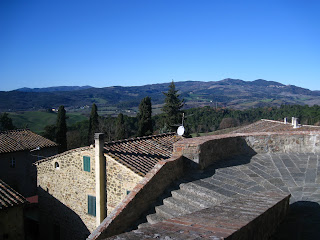We all know that Italians are born carbohydrate addicts. Pasta, pizza, and more kinds of bread then you can count. Bread salad. Bread soup. It's common knowledge, and unlike many Americans, I'm not opposed to that. I'm a carbohydrate believer too, and not the whole grain kind, but that doesn't help me much with my biggest shopping problem and Manuel's biggest issue with my shopping.
I forget to buy bread every day. Not that I forget per se, but more that I go down to Franca or Gianni (the two shops open in town) around 6, and there are just empty bread baskets behind the counter, mocking my tardiness with crumbs. Franca sees me eyeing the baskets, desperate, and shakes her head sympathetically.
"
Non c'è più". No more bread. Again. Shoot.
 |
| My bright, shiny new scale |
This is the fifth time in a row, and I'm starting to think Manuel feels I'm forgetting bread to torture him. I've tried every bread free meal I can - stir-fry, pho, tacos (WITH tortilla) - the man needs bread. And since after the flood, there are only 2 shops open, it's a bread draught in the afternoon. The early bird catches the ciabatta, so to speak. I wasn't alone yesterday, as another one of my friends rushed in, brushing past me with a hurried "Ciao" then gazed at the empty cases. "Noooooo!" he yelled, as though he had been shot. He threatened to call the mayor, half-kidding. We locked eyes as he noticed my dejected face and bread-less hands. He ran down the street to the other store, beating me as I paid for the rest of my groceries, nervous that I'd see him parting with the last piece.
I hurried there and saw him leaving with a packaged bag of crostini.
Whew. But my catty happiness about his lack of bread soon sank into my realization that I had failed again. I ran into an employee of the restaurant, who asked me what was wrong. I explained I needed bread. He looked at me like I said I just killed a unicorn.
"
Non hai comprato pane oggi?" he queried, confused. You didn't buy bread today?
I forgot, I lied, stammering, ignoring the fact that I forget more then I remember. Then a short lecture ensued as I was again reminded that we only have 2 stores open, the flood, everyone needs bread, Italians need bread...and so forth. My American bread failure loomed in the air between us. He looked at his watch.
 |
| Before the oven... |
"
Hai tempo da farlo". You have time to make it.
 |
| Cooked to perfection! |
And so I rushed home and my foccacia adventure began. Though man cannot live by bread alone, foccacia is another story. One of the most identifiable Italian foods for Americans, the bread ranges from flat and crispy to soft, oily and tall, and is a specialty of the region. In fact, in
Recco, they make a foccacia paper thin and stuffed with cheese, that is so famous it's up for the same European recognition as products like
prosciutto di Parma and
acciughe sotto sale del Mar Ligure. This status, called IGP in Italian (
Indicazione Geografica Protetta, or Protected Geographical Indication in English), recognizes gastronomic specialties of the utmost cultural importance. Foccacia is serious business, and in addition to that, one of my absolute favorite things about life in Liguria. I can eat foccacia all day. It's addictive and wonderful, and even when I fly back to the U.S., I bring a huge piece with me on the plane. First, it gets through security, and second I'm happily chomping away, and aware of many envious stares of my Italian plane-mates as they choke down the microwaved chicken. A fan of bread I am, but foccacia is tenfold.
 |
| Foccacia with herbs and sale grosso |
 |
| Italian yeast, much different from what I'm used to |
My American bread purchasing uselessness was now translated into my American bread making willpower. I found a recipe and got to work until Manuel got home, laughed at me, and helped out. It's actually easier then I thought, and Italian yeast, though strange to me, works just as well as our packaged yeast in the U.S. Beer yeast (bread yeast) comes in a squishy cube, and that plus my concession of buying a scale to weigh ingredients made me feel very adventurous. My cups and teaspoons had been working just fine, and I stubbornly cluing to them as long as I could, but it's tedious to translate recipes this way. The measurements get strange - i.e. 1 3/7 of a table spoon. Just odd. So, the scale was bought the other day and christened as I weighed out 300 grams of flour, 6 grams of large grain salt, a pinch of sugar, and then mixed some yeast, tepid water and olive oil in a bowl. I let it sit for an hour, spread it out on some round pans, and baked it at 190 C for 20 minutes (my oven is also European). We scattered more salt and oil across one, and a mixture of salt and dried herbs across another - rosemary, thyme, marjoram.
The foccacia was a success, and now I have a wonderful and quick excuse the next time I forget. IGP, DOC - it's none of these. However, it's delicious, easy and fast way to make everyone happy at dinner time - Italian or not.
 It's snowing.
It's snowing.










































